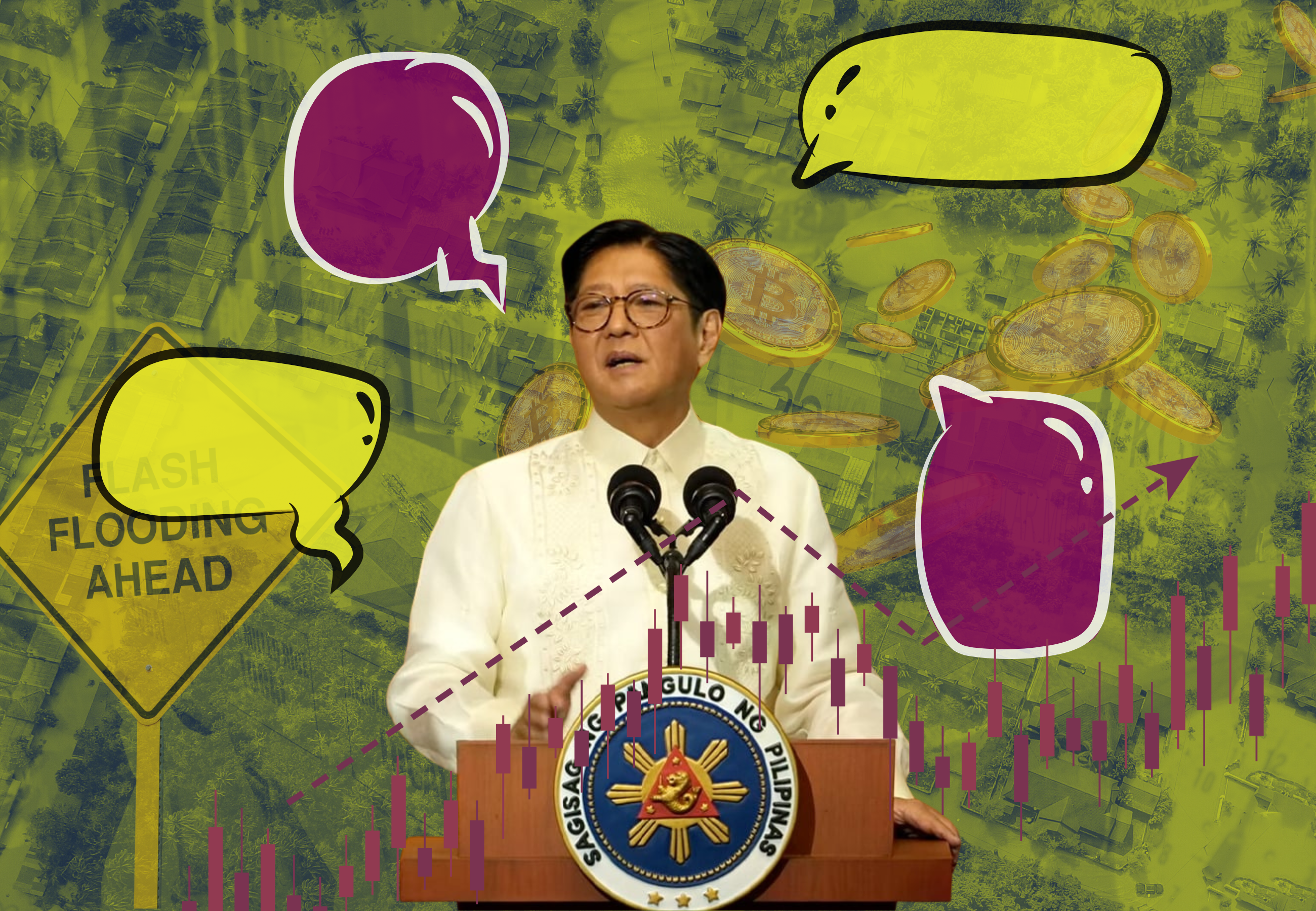A safe SONA, a cautious press
PRESIDENT FERDINAND Marcos Jr. delivered his fourth State of the Nation Address (SONA) on July 28, 2025, filling an hour and 11 minutes with feel-good updates on rice subsidies, infrastructure buildup, and the increased use of digitalization for governance. It seemed clear he did not wish to reckon with long-standing problems, complaints, and woes; he retreated into the shelter of tried and tested populist rhetoric.
His speech, delivered amid worsening flood disasters and economic headwinds, played safe. Media coverage — despite its breadth — was mostly descriptive and largely uncritical.
Populism over policy
President Marcos opened by claiming the economy is “in good shape,” pointing to improvements in inflation and employment numbers.
He announced the so-called success of the PHP20/kilo rice program and its readiness for nationwide expansion. The President claimed the price point had already been met in some Kadiwa stores, thanks to a massive PHP113 billion subsidy plan – which was promptly flagged as misleading.
Marcos also reiterated promises for transport fare discounts, scholarships, and free sports programs—including a nostalgic nod to the “Love Bus,” a transport initiative popularized during the Marcos dictatorship by his mother, Imelda Marcos. There was no talk about how these subsidies would be funded.
He devoted a portion of his speech to flood control and infrastructure review, a response to the recent flooding; as he announced a “comprehensive assessment” of past and present projects, citing the need to fix engineering and enforcement issues.
But the speech sounded rote, as though the president himself had not really thought out the initiatives, nor discussed these with his Cabinet. The Department of Public Works and Highways (DPWH) has already approved over PHP1 trillion in flood control funding over three years, much of it inserted without Congress vetting.
Media devoted more space and time to the optics of the event. The Palace announced no red carpet this year, citing “solidarity with flood victims.” Vice President Sara Duterte was notably absent, which reports read as a sign of the deepening rift between her and Marcos.
Security fielded 27,000 police personnel in Metro Manila—the largest SONA deployment under Marcos so far. Outside Batasang Pambansa, protesters gathered along Commonwealth Avenue, calling attention to human rights abuses, low wages, and climate inaction. Independent outfits such as Altermidya and Bulatlat gave these demonstrations comprehensive coverage, in contrast to the more muted treatment by mainstream networks.
Television networks mounted full-scale coverage ahead of the speech. TV5 began its special coverage early at 3:00 PM, offering data-rich infographics and featuring Chief Analyst Edson Guido providing brief explanations.
GMA Integrated News delivered the most expansive multimedia setup, simulcasting on radio, TV, and online platforms.
ABS-CBN featured more analytical commentary with lengthy interviews with resource persons after the event. Professor Julio Teehankee of De La Salle University said that the SONA served as a “prelude to legacy”, perhaps to counter recent political setbacks experienced by the administration. He warned that Marcos faces an “existential crisis,” namely, his anti-corruption campaign, while rhetorically strong, has lacked operational clarity.
Selected silence
Rappler’s list of SONA-absent issues included the education crisis, PhilHealth’s troubled operations, the unresolved pension reform for military and uniformed personnel (MUPs), and the increased cost of doing business in the country. These omissions, Rappler argued, reflected a president unwilling to engage with complex, systemic issues. In a follow-up analysis, Rappler also examined the numbers Marcos cited, warning that while the figures were optimistic, these only paint a “rosier” picture.
More directly, Bulatlat called out the president for ignoring the country’s worsening health care situation, living wage demands, crucial agrarian reform issues, and the continuing denial of accountability over human rights abuses under his watch.
Several other media did as much. Inquirer.net, citing Pulse Asia survey results, reminded readers that inflation, low wages, corruption, and job security remain top citizen concerns—none of which were addressed in concrete terms in the SONA. The paper’s editorial, “Mahiya Naman Kayo,” questioned whether government officials truly grasp the hardship of Filipinos. It warned against a governance style that puts the performative aspects ahead of its accountability to provide genuine public services and goods.
BusinessWorld and The Manila Times took a more policy-specific angle, pointing out the blanks in the SONA that included key revenue and regulation issues, such as e-gaming tariffs and the country’s controversial relationship with offshore gaming operators (POGOs).
Environmental concerns were also swept aside, as noted by Philstar.com in its environment-focused coverage on disaster preparedness, with Marcos only having vague statements.
Taken together, these media reports and expert views presented a composite portrait of the SONA as a carefully managed spectacle, emphasizing continuity, optimism, and its “Bagong Pilipinas” brand. It may have resonated in form and presentation; but it remained strikingly banal, lacking gravitas.
Journalists and analysts were quick to identify what was omitted, why these mattered, and what all of it said about Ferdinand Marcos Jr. as a leader.
More than safe scripts
President Marcos Jr.’s 2025 SONA aimed to reassure, not to reform. While the country reels from natural disasters and the fiscal strain binds the nation, he used the occasion to engender optimism, offering the promise of subsidies and nostalgia.
But he stepped back from doing the hard work of assessing the challenges he and the people face. The discussion of debt, education, public health, and corruption was shelved for the occasion.
While some outlets served up thoughtful criticism, the rest merely reported what they saw, describing the show as spectacle, but not examining its meaning as theater.
Media seem to have let things be. But as the Marcos presidency enters its second set of three years, the media must stir to a sense of its mandate. Holding the government accountable is a constant and continuing exercise for the national community. The public can do a better job at evaluating leadership with the assistance of an active and vigilant press.

Leave a Reply